Bonjour! I'm Emily. Welcome to my little corner of the internet dedicated to all things Parisienne. I hope to share my experiences, thoughts, and creations while in the City of Light and beyond.
Don't wanna be here? Send us removal request.
Text
On Religion in Paris
Don’t Talk About Religion or Politics
Prior to coming to France, someone told me above all not to discuss religion or politics with the French. At the time, I dismissed the comment-- because hello, I can’t even order food properly let alone have an in-depth conversation in French. But now that comment sticks out to me as being relevant and worth reflecting on. Why not discuss these topics? After two weeks in Paris, I am beginning to see why this was recommended to me-- the complexity, rich history, fears, and connotations associated with these topics have been made evident. However, I will now consider one of these topics, religion, in this “safe” corner of the internet...

I must say, nothing confuses me more than the religious landscape of Paris. I think prior to this trip I expected Paris to be more similar to American cities in the way of accepting religious diversity than what it is. For instance, I thought that as Paris exists as a giant melting pot of people, all are welcome as they are, religion included-- but this is not the case.
A Lack of Religion
First and foremost, my error in assumption was made evident by the observed lack of religion in Paris. Paris may be a melting pot of people, but from my perception, “religion” in a traditional sense largely seemed absent from the public sphere. If anything, the diverse people groups in Paris were united in their apparent rejection of religion.
Secularism was intensely present (which can be considered a religion of its own, although many would disagree with me here). I didn’t really see the outward practicing of religion of any sort while I was in Paris, other than when I attended Mass and visited the Grand Paris Mosque. Even though the majority religion practiced in France is Christianity, with around three-fifths of French proclaiming a Roman-Catholic affiliation, only around 5% actively practice their faith. The closest activities I saw to practicing religion included a man holding a “You Need Jesus” sign outside our Metro station one afternoon and a man reading Battlefield of the Mind by Joyce Meyer, a Christian book I’ve read, on the train. I didn’t see any signs or advertisements for religious events. No Bible verses on bill-boards (although interestingly enough I did see Jeremiah 29:11 used in a Valentino ad, but it was displayed un-attributed to the Bible).

Laïcité
It is important to know that the French have a specific, quintessentially “French” type of secularism in effect: laïcité. Stemming from the Revolution, laïcité indicates the state protection of citizens from the effects of organized religion. This means that religious expression is prohibited in public spheres and cannot be forced upon anyone. The French can practice their own religion, but behind closed doors (hence my lack of organized religion sightings). In essence, religion in France is not something to bring into the public sphere, and should have nothing to do with the state.
Attending Mass In Paris
I had the opportunity to attend mass on two different occasions in Paris, at Saint-Germain-l'Auxerrois and Saint-Eustache. As a Christian, I enjoyed both services immensely even though I did not speak French. I am not Catholic and had no idea what what going on most of the time, but I appreciated the beauty of the church, the practices of the priest and the congregation, and the way in which I was still able to connect to God.


However, what struck me as odd and honestly quite sad was that the majority of the congregations in both services were composed of tourists. This tells me that Christianity no longer is seen as a collective national identity for France. There is a definitive disconnect between the ideals of Parisian society and Christianity. Christianity has become outdated and old. Churches are spectacles and admired more for their design and architecture instead of the sacredness they embody.
I’m glad these tourists (myself included, I know I’m a hypocrite) could make the pilgrimage to these incredible places of worship, but at the same time, my heart hurts for the lack of local dedication in these churches. Who is left when all the tourists leave? How many regular attenders do these churches actually have? How does the frequent influx of tourists affect them? Maybe regular attenders appreciate tourists coming to make their numbers bigger and to get more support for their churches... Maybe some are completely infuriated by tourists’ behavior and lack of respect at times... I’m sure both ends of the spectrum are true.

Muslims in France
One of the reasons why one should refrain from talking about religion in France is because doing so would sooner or later lead to talking about immigration and Islam, which is both a religious and political topic (double whammy, oh no). As of late, discrimination against immigrants, especially Muslim immigrants, has been a real issue in France and Islamophobia is rampant. It’s no secret that France’s Muslim population has grown due to the influx of immigrants from majority-Muslim countries. Yet what remains largely hidden from the public eye (and especially from tourists) is the fact that France really does not know how to handle its current immigration issues, promote diversity, and continue the practice of laïcité in a way that authentically gives citizens equal human rights. The face and identity of Paris is changing-- how will Parisian society and government respond, shape this change, and seek to benefit all Parisians? Is laïcité the best way to dictate the split between church and state? This is a valid question, and one I cannot answer, but I hope that Muslims, along with everyone of every faith in France, have the freedom and support to practice their religion.

Visiting the Grand Mosque of Paris
The moment I stepped into the Grand Mosque of Paris, I was met with a sensation of tranquility and peace. Beautiful mosaics decorated the floors and a garden offered serenity and a sweet fragrance. The architecture was simple yet elegant and served the purpose of pointing one to God. Never before had I been in a mosque. To be honest, I didn’t know much about Islam (and still do not), but I was eager to learn about the faith and partake in the experience of being in a different religious space.

Interestingly enough, though I still grapple with the differences between Christians and Muslims, overall my experience in the mosque reiterated the similarities Christianity and Islam share. I was both humbled and surprised by these similarities in terms of faith, practice, and worship. They are both monotheistic religions. Both are “religions of the book” and recognize many of the same prophets and teachers. As I alluded to above, even the structures designed for worship and community in both faiths are similar.


Differences exist, don’t get me wrong, but being in this place of worship allowed me to gain a deeper understanding of Islam and a deeper respect for Muslims. I came to understand my own faith in a new way as well. I think if more people in France (and across the globe) were dedicated to mutual respect and seeking understanding through dialogue and shared experiences, instead of focusing on differences and dividing lines, discrimination would not be such a problem.
To Conclude
I still can’t wrap my head around religion in France; I need to study France further and gain a deeper understanding of the place. But also my lack of understanding comes from who I am; I am an American, not French, and some of the mindsets, history, and practices ingrained so profoundly in France will always be foreign to me.
Sources: “France - Religion”, “Religion in France”

#france#hopecollege#hopecollegeparis#paris#parisfrance#parisstories#travel#travelblog#french#parisian#religion#christianity#islam#mosque#church#cathedral#entry1
3 notes
·
View notes
Text
A Place of Memory, Beauty & Unity
I must say, I don’t normally like visiting cemeteries. Some of my friends enjoy going to cemeteries to walk, sketch, read, explore, breathe etc. but I find it often eerie and strange to be “among the dead”. I’d rather go some place else, thank you very much. I can’t quite pinpoint my finger on why I feel this way, but nonetheless, this has been my experience.
I expected Pere Lachaise to be like every other cemetery I’ve visited: numerous look-alike tombs spread out in a vast park of sorts. Green grass. Flowers atop a few of the grave sites. Creepily quiet. I didn’t understand what all the hype was about for this particular cemetery. I knew it was big and all, but what made it so special?

Looking back now, I wonder at how I could have ever had this sort of view of Pere Lachaise. How wrong my expectations were, such low standards I had set! Just like with people, one should always be cautious in how one judges a place without having ever been...
I don’t really know how to put my first encounter with Pere Lachaise into words, but I’ll make an attempt. The best I can liken it to was stepping into a sanctuary of sorts. Outside the walls of Pere Lachaise, the city rumbles and screeches, but once one crosses the threshold into the cemetery, they are met with instant peace, a somber welcoming, and an elegant beauty. This sanctuary tenderly holds its visitors. It invites them to pause, to remember, to feel, to appreciate, to empathize. With its winding avenues and stone paths, it tells one to stay a while, to move and breathe while life still ebbs and flows with every beat of one’s heart.

After only a few moments in Pere Lachaise, my impressions of the cemetery completely shifted. Where I was previously skeptical, now I was open. I began to question-- what could I learn from Pere Lachaise? What perspectives did this place have to offer me? What secrets did it hold? I walked, observing hundreds of grave sites, with these questions in mind and soon I found myself engaged in a dialogue with Pere Lachaise. I mostly just listened, but I think it is significant that I brought my whole self to the conversation, open to what this place had to say.

Here are a few lessons I learned from Pere Lachaise, in no particular order:
1. Death brings unification
Oddly and beautifully and sadly enough, we are unified in death- rich and poor, old and young, famous and ordinary. We all must pass away from this earth. We all receive a period of time to live... and this precious time does not last forever. While I walked among the deceased, I was reminded of Mary Oliver’s question: “What will you do with your one precious life?” I wondered what all these people, now gone, had done with theirs.
In Pere Lachaise, the idea of unification in death came to mind even more profoundly as I observed the placement of the tombs. People who were once famous were next to those who were not. Flowers and symbols of memory decorated the graves of both. While each of the tombs were different from one another, and while each person buried at Pere Lachaise had lived unique lives, the dead lay together—peacefully, without complaint... to be remembered and commemorated.


2. Beauty and sadness can coexist
Decorated with hundreds of tall, ancient trees, rough cobblestones, winding paths, and patches of flowers here and there, Pere Lachaise instantly establishes itself as a cocoon of beauty. Visitors wander, they are met with silence and reverie. The tombs of many stand ornately created, with supreme attention to design and detail. They are works of art in and of themselves.
While each is beautiful in their own way, one of the most beautiful graves I visited was Géricault’s. Remembered most for being an artist, a sculpture of Géricault sits atop the tomb, palette and paint brush in hand. He gazes intently to the right, almost regally. Around the sides of his tomb, his most famous paintings, including Raft of the Medusa, are sculpted as relief sculptures in a much smaller scale than the originals. A small iron fence, composed of many “G’s” in the metal-working, surrounds the space directly in front of the tomb.

I couldn’t help but think: how fitting— an artist has received a work of art for a resting place. Yet at the same time, as I gazed at Géricault’s grave, I remembered that he had died young at 27 and was met with a supreme sadness. Had he lived longer, what other works would he have produced? What further messages had he to offer the world?
And all of a sudden, the beautiful facade of Pere Lachaise seemed to give way to the extreme sadness held within this place. While it most definitely showcases beauty, one must remember that this place also holds deep loss, pain, and sorrow. The graves around me indicate actual people who lived, actual people with families, identities, dreams and goals... just like me.
3. Visiting a tomb can be a vehicle of empathy
Standing before a gravesite, it is impossible not to face the reality of loss— this person, once glittering with life and zest, is now gone. And it is precisely this sense of lostness that constitutes a feeling of emptiness. Emptiness, in turn, transforms into an acute pain.
I felt this pain in some form, to varying degrees, at each tomb I visited. In standing before the deceased, I imagined what it must have been like for family members and close friends of the now deceased to stand in my place, to watch the casket being lowered into the cold earth. I know their pain. I know what it feels like to lose a loved one. Surely we all do, and if not yet, this feeling will come— it is inevitable. And here it is again— the unification death brings— not only as the grand equaliser but also in a way that makes us, the still-living beings, empathise with one another, relate to one another. Death is supreme brokenness and begets brokenness, yet in it is on our shared experiences of brokenness that we can come together.

4. There are different forms of commemoration
Here I must return to my shallow preconceived notions of cemeteries and Pere Lachaise in particular. It turns out I had a very limited knowledge-base of what forms commemoration can take. I knew only of the typical: placing flowers on graves. At Pere Lachaise I witnessed not only an abundance of bouquet sightings, but also a variety of ways in which the dead were honoured through poems, photographs, decorative trinkets, and for Jewish gravesides, the placing of stones on top of tombs. Much of this memorabilia was left near the tomb or on the tomb itself.
What interested me further was the observation that many of these methods of connotation were ephemeral— they will not outlast the harshness of the weather, the endurance of time and possible interference of other human beings. Yet now another thought— are we, too, ephemeral, if only in the most basic sense? Like the wilting flowers on Edith Piaf’s grave, we do not last forever. So how do we, while still living, commemorate both the deaths of those loved fiercely but also the life that still beats within, (while it is still here)?


5. Sometimes there are no words, and this is okay
Especially when considering a topic such as death, the pressure to speak and articulate what one thinks and feels and perceives all the time can be paralysing and suffocating. Death, loss, pain, brokenness— they all do not make sense, so how are we supposed to make sense of them, especially right away? I don’t think we are ever to “make sense of” death; to do so would be to lose all feeling and emotion in favour of rationalisation. The problem with death, loss, pain, and brokenness is that they are not supposed to exist in the first place. And thus we cry, we pause, we stand with words jumbled in our mouths at the grave sites of those now gone. What could we possibly say? What words could do justice? Being there is enough. Most often in Pere Lachaise, at the grave-sites I stood speechless yet observant, afraid of my lack of articulation but comforted that I did not have to convey everything going on inside of me. In my silence I could listen, and if places could speak, Pere Lachaise seemed to say, “It doesn’t all make sense, and it doesn’t have to. You do not have to speak; you simply have to be, right now, in this moment. This is what is required of you.”

Graves I Visited:
-David
-Gericault
-Edith Piaf
-Delacroix
-Oscar Wilde
-Gertrude Stein and Alice Toklas
-Chopin
-Abelard and Heloise
-Modigliani
Merci, Pere Lachaise, for the lessons you taught me.
Sources: Michelin Green Guide
#france#hopecollege#hopecollegeparis#paris#parisfrance#parisstories#travel#travelblog#french#parisian#entry3#perelachaise#cemetery#grief#loss#beauty#serene#graveyard
2 notes
·
View notes
Text
best. final exam. ever. (a blog detailing the scavenger hunt final exam for Paris 2019)
Today we did our final exam for this May Term, and I have to say: BEST. EXAM. EVER. Exploring new places in Paris? Yes please! We were given some expectations and then a list of sites to visit with a partner, and then left to figure out which route we would like to go! I’m glad I like directions and navigating because today was a whole lot of that.
(Note: I posted the pictures with the locations tagged on my Instagram, @kyliegtravels, if you would like to see exact locations. They are all under my “final exam” highlight.)

Picture from Paris Stories at Hope College Facebook
The following is the expectations/rules we were given this morning (bright and early at 8am) for the day.
Objective:
Demonstrate proficiency in Pairs by:
1. Ability to successfully navigate mass transit. You must use the metro and/or the buses to get around. NO UBER.NO TAXI.
2. Referencing only your Paris Pratique and Michelin Guide for directions—not cell phones. Should it be revealed that you used your cell phone for navigational purposes, you and your partner will receive an automatic failing grade on the exam.
3. Find historically/culturally significant locations per the list provided, and experience them.
4. Do so in an efficient way (within the 6 hour limit).
5. We encourage you to take a break for lunch, snacks, etc.
Mechanics:
· 8 am start time from the Citadines Place d’Italie
· You may NOT use computers and phones to plan the best route. Your sites are not listed in any geographical “order.”
· 2pm arrival (not earlier) at the professors’ apartment: rue Watteau
o Please bring your laptops and your Michelin Green Guide to rue Watteau. (Pick these at the Citadines before arriving at rue Watteau)
· YOU MUST VISIT EACH SITE WITH YOUR PARTNER
· Each group must take a photo at each site, and slow down a bit, and think about the space.
· Back at the professors’ apartment (or if you finish early, please feel free to begin working), make Tumblr posts documenting your groups journey—including each site visited.
o Divide the blog posts between partners/group members.
o If you reference a source, please be sure to include the citation. Your Michelin Guide is a great reference.
After reviewing these expectations, we were given our partners and the list of our sites.
Group 1: Rousseau (Emily and Kylie)
1. In front of a street sign on rue Jean-Jacques Rousseau (1er)
2. On the steps of the La Madeleine (8e), Place de la Madeleine
3. In the Place des Vosges (3e)
4. In the center of the Arenes de Lutece (5e), 49 rue Monge
5. The exterior façade of St-Etienne-du-Mont church (5e), Place Sainte-Genevieve
6. Galerie Vivienne (covered passage, 2e), 4 rue des Petits-Champs
7. Inside the Gare Saint-Lazare SNCF (big trains) train station, the one painted often by Monet (8e), 13 rue d’Amsterdam
8. Place Edith Piaf (20e)
9. Temple of Sibyl, Parc des Buttes Chaumont (19e)
Emily and I went to work to figure out what the best way to find each of these places would be. We used our Michelin Green Guides and our Paris Pratique to craft our path. The following is the path we followed to complete our final exam. We started out by taking line 7 (La Courneve) to Place Monge to our first site.


Arenes de Lutece:
We decided to go here first because it was the closest to our hotel, and we had seen signs for it in the line 7 Metro. It was pretty easy to find when we came up out of the metro because there were signs for it, so I expected more people to be there. We were the only people there. I’m not sure if that’s because we were there at 8:15am. The Arenes De Lutece and is located in the Latin Quarter. It is an amphitheater and could originally hold 15,000 people. It is one of the only surviving evidence of the Roman period in Paris. It was interesting to see that apartment buildings have been built over part of the amphitheater. We enjoyed appreciating the calm arena before we set off on the rest of our day. We decided earlier to walk to the next site because it was in the same arrondisement and it didn’t make sense to take a Metro.
Source: https://www.parisinfo.com/musee-monument-paris/71451/Arenes-de-Lutece-et-square-Capitan


St-Etienne-du-Mont Church and Place Sainte Genevieve:
We walked down some winding streets, which is the character of the Latin Quarter to find St-Etienne-du-Mont Church. I’m not going to lie, this was pretty easy to find because it is so distinguishable. It was cool to see the Pantheon next to it too. In fact, in 1744 King Louis XV replaced the Saint Genevieve Abbey with the Pantheon. The abbey was looted and burned in the Revolution. It was attached to what is now called St-Etienne-du-Mont Church. This is why the place near the church is called the Place Sainte Genevieve. I had never heard of this church before and] the façade of it is quite grandiose, Renaissance style. It was restored after the revolution and actually slants left due to the shape of the ground. According to the churches website, it is a product of a transition period between gothic and Renaissance styles. I think this is for sure true because of what we have learned about the two styles in class. Another interesting thing about this area is that the original wall fortification is still present in some areas and we just happened to walk by, how cool! We then continued our walk to the Cardinal Lemoine station and took line 10 (Gare d’Austerlitz) to Gare d’Austerlitz and transferred to line 5 (Bobigny), exiting at Bastille.
Source: https://www.saintetiennedumont.fr/en


Place de Vosges:
Check out Emily’s blog for this entry at. https://thepariscollective.tumblr.com/tagged/scavengerhunt!
After exploring Place de Vosges, we walked to the Chemin Vert Station and took line 8 (Balard) to Republique and transferred to line 3 (Galleieni) and got off at Porte de Bagnolet.


Place Edith Piaf:
I was surprised because we popped out of the underground Metro station into a market and the statue of Edith Piaf was on our right. Emily has the entry for this site too! We enjoyed a walk through the market before embarking to our next site, which was the one we knew the least about. We went to the Gambetta station and took line 3 (Levallois) to Pere Lachaise, then transferred to line 2 (Porte Dauphine) and got off at Belleville.


Temple of Sibyl, Parc des Buttes Chaumont:
We found the Parc des Buttes Chaumont easily In our Paris Pratique, but the Temple of Sibyl wasn’t labeled so we ended up looking it up in our Michelin guide while on the Metro and finding a map of the entire Parc. It was quite a hike to find this site (which makes sense because the 19this near Montmatre) and it was definitely not a tourist area so it wasn’t labeled from the streets. I think this may have been my favorite site we visited. In 1860, Napoleon III integrated the areas surrounding the park into the city, creating a need to make these areas “Parisian.” Haussmann played a role in the installation of this park, a large English-style park, along with the Bois de Boulogne and the Bois de Vincenne. Adolphe Alphand created this park by buying 25 hectagres of the Buttes Chaumont. Originally this had been quarries, but they were abandoned in the mid 1800s. It was a three year process to form the park from construction of artificial cliffs (the one in the lake where the temple is located is the most prominent) to digging trails both steep and flat to planting new species. The lake was created by using a local water tank. The park was inaugurated with the Universal Exhibition of 1867, when Napoleon III wanted to show off his newly Haussmannized capital. I would love to go back and explore this park when I have more time because it looked like there was lots of trails and different paths to explore. Emily has a little more about the Temple of Sibyl on her blog if you would like to read more about that. We hopped on the 7b (Pre-St.-Gervais) and got off at Place des Fetes, then got on line 11 (Chatlet) to Arts et Metiers, and then line 3 (Levallois) to Bourse.
Source: https://www.histoires-de-paris.fr/parc-buttes-chaumont/


Galerie Vivienne:
I knew from our assignment sheet that this was a covered passage, but as we stepped into it, it was much more extravagant than I expected. It felt like I was in a department store because the ornamentation of the ceiling or the glass roof and the detailed floor felt too special to just be a street passage. It was built in 1823 and now houses a cute bookstore, boutiques of various kinds, food shops, and probably more that we didn’t see because the spectacle of the passage itself was so beautiful. We walked through it and on to Rue Etienne Marcel to find our next site.
Source: https://en.parisinfo.com/paris-museum-monument/100272/Galerie-Vivienne

Rue Jean-Jacques-Rousseau:
This is the street our group was named after! Check our Emily’s blog to understand it’s importance. We walked from here to the nearby Etienne Marcel Metro stop. We got on line 4 (Cligancourt) to Strasbourg-St. Denis and transferred to line 8 (Balard) for the Madeleine stop.


On the steps of the La Madeleine, Place de la Madeleine:
You would think finding the front of the church would be easy, but it turns out we got turned around. We got out of the Metro and went towards the back of the church, and got super confused because it was locked. Not to mention, it was under construction, so that might also have added to the confusion of where the front was and it also doesn’t look like other churches in Paris, so we were a little shocked by that. Don’t worry though, we wandered around the place and found the front steps of the church. After looking into this place later, it is now well known for the little cookie/cakes that Marcel Proust made famous, but there is a deep history of the church. The church is situated between Place de la Concorde and the Palais Garnier. It is different than a religious building because Napoleon wanted it to be a pantheon to honor his armies. The iconic Corinthian colomns were under construction, but we still got to see some of them. We also saw many signs for concerts, which the church hosts regularly. From here we walked to our last location. We followed Rue Torchet towards Printemps and then Rue de Havre straight to the station.
Sources: https://en.parisinfo.com/transport/73127/Place-de-la-Madeleine,https://en.parisinfo.com/paris-museum-monument/71158/Eglise-de-la-Madeleine


Gare St. Lazare:
Emily wrote about this site too, but I want to mention how modernized this building was. I expected it to be more like what Monet painted, yet instead, it felt more like a mall. We had a hard time getting a picture inside of ourselves without it looking like a mall, so we took a few pictures inside and headed outside to get our selfie with the iconic sign.

Whew! That was a lot! We started at 8am and got done early (noon) before we had to be at our professors’ apartment at 2pm. Since we had time, we decided to pull up Dr. Janes’ food recommendations list and found Cosi, a sandwich shop in the 6th. It was fun to celebrate completing our exam with some delicious sandwiches. Then, we went to our professors’ apartment for a delicious spread and to work on our blog posts. I want to go back to so many of these places because we were on such a timed schedule today! I look forward to revisiting these places someday and knowing the history of them because I took an exam by finding them. This class was such a cool experience I never imagined myself doing after finishing my first year of college, but I’m so glad I did. My professors are absolutely amazing and I’m so grateful for them. They’ve given us such great guidance and tours at places around the city, but also the independence to wander and explore. I will never forget this trip and it was such a fun way to wrap it up with a whirlwind scavenger hunt of such a beautiful city.
4 notes
·
View notes
Text
Whirlwind Paris: a scavenger hunt
I’ve just completed perhaps the most blissful final exam of my life so far: a scavenger hunt around Paris! My professors split our class into pairs and handed us a list of places to find. The main rule: absolutely no phones! We had six hours to complete our hunt. Here are a few little blurbs about some of the places we visited (already I want to go back to all of them!). If any of you happen to visit Paris in the near future, I highly recommend these destinations, as many are off the beaten path and are not super “touristy” (hallelujah!).

Place Edith Piaf, 20th arr.
Situated in the 20th arrondissement, this place is named after the French singer Edith Giovanna Gassion, famously known as Edith Piaf, or “The Little Sparrow”. Fifteen years after Piaf’s death, the place was created as a site of remembrance and memory. In the middle of the place, a statue depicting Piaf singing with her arms outstretched overhead can be seen. Sculpted by Lisbeth Delisle, the statue was inaugurated in 2003 as a tribute to Piaf. Through the emotion and energy conveyed through the sculpture, one can almost hear Piaf singing her famous “Non je ne Regrette Rien”.
(Sources: “Follow the Footsteps of Edith Piaf in Paris” & “Les rues des Paris: la statue hommage a Edith Piaf”)


Rue Jean Jacques Rousseau, 1st arr.
Jean Jacques Rousseau, a Genevan philosopher, writer, and political theorist, heavily inspired leaders of the French Revolution and the Romantic generation. During his lifetime, he is considered one of the most if not the most influential philosopher, as his thought drew the Age of Reason to a close. Importantly, Rousseau highlighted “liberty as an object of almost universal aspiration”. At the age of 30, Rousseau moved to Paris. From 1774-1778, Rousseau lived on rue Plâtrière, his last home in Paris. In 1886, rue Plâtrière was renamed to rue Jean Jacques Rousseau to commemorate this truly influential thinker and philosopher. Also worthy of mention on this street is a cookery shop named E. Dehillerin, where famous American cook Julia Child would go to buy all of her cookware when she lived in France.
(Sources: “Les rues des Paris: la rue Jean Jacques Rousseau” & Jean-Jacques Rousseau Britannica entry)


Place des Vosges, 3rd & 4th arr.
The Place des Vosges exists as Paris’ oldest square. Once the site of the Hotel des Tournelles and acquired by the Crown in 1407, Catherine de’ Medici pulled down the residence following the death of Henri II. Later, in 1605, Henri IV transformed Place des Vosges to what it now appears as today. Upon our entrance, we were surrounded by elegant, symmetrical buildings that bordered a beautiful park dappled in morning sunshine. In the middle of the green space, a statue of Louis XIII stands. Fountains trickle nearby. The buildings bordering the park, which were once houses, contain a variety of shops and cafes on the bottom level, easily accessible from inside the place. Also of note are particular plaques of commemoration around the buildings that tell of former residents, like Victor Hugo at no. 6.
(Source: Michelin Guide, pp. 165-166)


Gare St. Lazare, 8th arr.
Located near rue Haussmann and the famous Printemps department store, Gare St. Lazare presents itself both as a large train-station and a modern shopping center. We were both surprised to find that the quintessentially Haussmannian-style facade of this building held such a sleek, modern interior, with a plethora of high-end shops to boot! The shopping center is a fairly new addition to the space, as major renovations have taken place over the past few years. With the addition of the shopping center, Gare St. Lazare pairs the old with the new and represents much of the character of Paris today-- both historical and increasingly modern. I especially enjoyed visiting this site because it was one of Monet’s favorite muses before he decided to focus solely on nature and the natural environment. He painted a variety of paintings inside Gare St. Lazare, focused on light, steam, and of course- the trains. I find it extremely interesting that during Monet’s life, Gare St. Lazare was a modern subject for him. In a new way, this place has taken on a new modernity, reiterating the idea that what is modern is always changing.
(Sources: “Monet, The Gare Saint-Lazare”, “St. Lazare train station- Paris” & “Gare Saint-Lazare - Paris tourist office”)


Buttes-Chaumont Park, 19th arr.
By far my favorite destination on our list, this glorious park is known for its sprawling greenery, steep cliffs, and rolling hills. An island is located in the middle of the park, where the Temple of Sibyl rests. This Corinthian-style temple was created after a Roman temple bearing the same name in Tivoli, Italy. The Roman temple was built around the second century BC. Despite the intense climb, the view from the top of the Temple is absolutely wonderful. One can see over Paris, all the way across to Montmartre and over St. Denis. We couldn’t help but take the time to appreciate the view, even amidst our crazy time-crunched scavenger hunt across Paris!
(Sources: Michelin Green Guide, pp. 318-319 & “The Temple of the Sybil- Visit Tivoli”)
For reference, here was our complete list of places to visit:
1. In front of a street sign on rue Jean-Jacques Rousseau
2. On the steps of the La Madeleine, Place de la Madeleine
3. In the Place des Vosges
4. In the center of the Arenas de Lutuce, 49 rue Monge
5. The exterior facade of St. Etienne du Mont church, Place Sainte-Genevieve
6. Galerie Vivienne (covered passage), 4 rue des Petits-Champs
7. Inside the Gare Saint-Lazare SNCF
8. Place Edith Piaf
9. Temple of Sibyl, Parc des Buttes Chaumont

We finished around four hours in, with enough time to snag lunch at the original Cosi. Yum!
All in all, this was a final exam I’ll never forget... a place I’ll never forget... je t’aime, Paris!
#france#hopecollege#hopecollegeparis#paris#parisfrance#parisstories#travel#travelblog#french#parisian#finalexam#scavengerhunt#fun#adventure
5 notes
·
View notes
Text
Hic et Nunc (Here and now): the challenge of immigration in France
This morning at the market I met a fruit and veg seller from Egypt. He spoke a bit of English, so we had a short conversation in fits and starts, choppy sentences and lots of head nodding and probably too many utterances of “oui”. Laughing at my market list, he graciously helped me find “petit oignon”, “echalates”, “frambroises”, and “bananes”. It wasn’t until the end of the conversation that he told me he was from Egypt. He said he’d be traveling there in two months.
In this moment I wished I could readily speak French, as I wanted to know more about this man. What was his story? What was his experience in France? What was it like being an immigrant to a country that has traditionally been resistant to multiculturalism and diversity? Why did he come to Paris? How did he become a market seller?
These questions remain unanswered. Yet after my short exchange with him, I was reminded of an exhibition I attended the other day at the Musée de l'Homme, entitled: “His et Nunc” (Here and Now). The exhibition features photographs by French photographer Clarisse Rebotier and explores how migrants arrive in France and are welcomed and integrated into society.

While I know that the market seller I met this morning has a personal story relative to his experience, I cannot help but wonder what connections could be made between his life and the lives of other immigrants showcased in this small exhibition... And now as I reflect on the exhibition, this was the main message of Rebotier after all-- each immigrant to France is first and foremost an individual with a unique story worthy of considering.

Placed within the context of a larger exhibition, “Saison en droits!”, which commemorates the 70th anniversary of the Universal Declaration of Human Rights, thirty black and white portraits of French immigrants and refugees are displayed on a single wall. Subjects are photographed on the Esplanade of Human Rights at Trocadero, with the Eiffel Tower in the background.

The Eiffel Tower, while blurry behind the subjects, stands as a symbol representative of France, rooted in time and place. This in turn allows the photographed individuals to be rooted in time and place, be it for the quick snap of a photograph; many of these individuals have come to France fleeing war in their home countries. Most importantly, the depiction of the Eiffel Tower in each of the thirty portraits reveals that the Eiffel Tower belongs to everyone. This idea, taken as a key theme, can point to Rebotier’s underlying message that France should be and is for everyone.
Looking at Rebotier’s documentary and artistic photographs, we glimpse smiling and peaceful immigrants, migrants, and refugees. Yet it is of supreme importance to recognize that the subjects in each of the photographs are not just immigrants, migrants, and refugees, but people with an identity.
Rebotier has highlighted the identity of each of her subjects in two major ways. First, the names of each of her subjects are written in pencil next to their photographs on the museum wall. This is significant because a name holds one’s individuality. A name personalizes a story... for there is danger when we generalize, make assumptions, and consider “a single story” representative of any people group.

Considering the topic of immigrants in France, Rebotier says, “Although I often hear about people who are ‘different’, personally, I still haven’t understood what they’re supposed to be different from...?”
The people photographed are more than immigrants, they are human beings with lived experiences-- deep sorrows and triumphant joys-- just like you and I. Written on the walls within this context, a name holds power; it distinguishes each person from one another but relates us all in the solidarity of being human.
The second way in which Rebotier has highlighted identity includes transforming her exhibition into more of a participatory project. By letting each of her subjects develop their own photographs in the dark room, these individuals have become authors and artists themselves. This action, while simple, is profound in the way it communicates the idea of ownership over one’s life. Even though welcoming diversity and integrating refugees is currently a great challenge for France, immigrants and refugees do not and should not have to live subjugated solely under the titles of “immigrant”, “refugee”, or “migrant”. While these titles are part of their story and who they are at the moment, but it does not make up who they are in totality.
We all must be empowered to embark on our own paths and live freely, unhindered by stereotypes and paths others have laid out before us to follow.

“They’re cheerful. They’re fighters! I wanted to show that refugees are first and foremost citizens who are incredibly full of emotions and life,” states Rebotier.
After viewing this exhibition, I say let this be the new mantra for France. Through these small yet impactful images, I have hope for Paris and the fight for equality here. But still the hard work of change needs to be done.
One voice, that of Clarisee Rebotier’s, has spoken out-- and more still need to join-- because largely those who have suffered from discrimination have been silenced. Let the voices rise, against all forms of discrimination, and instead for unity. And may I add-- this is not an issue to be highlighted because of the 70th anniversary of the Universal Declaration of Human Rights, but because it truly matters HIC ET NUNC-- here and now.

#france#hopecollege#hopecollegeparis#paris#parisfrance#parisstories#travel#travelblog#french#parisian#photography#photos#immigration#individuality#strength#unity#humanrights#entry2#exhibition#art#documentary
7 notes
·
View notes
Text
I’ll Cling to the Beauty


Suddenly we have three full days left in Paris and I’m beginning to feel the anxious tug between two places--home and here. I want to go home but also I feel such a deep connection to Paris and I wish I could stay longer, delve further into this complex place and culture... learn French! and actually form relationships with Parisians.
Maybe the grace to return will be extended to me, but until then, I’ll remember Paris and hold her within my heart... she’ll still be teaching me lessons, no doubt, long after I’m gone.

Something I’ve been grappling with while in Paris is the question of how to heal while still “doing life”, refusing to be stagnant in processing and brokenness but to keep on moving and living. This past academic year has been exceptionally difficult, and to be quite honest, I’m burnt out. But the world doesn’t stop for any one of us, even though it seems like it should as we chase it down and try to grasp it as it chugs away like one of the metro trains in Paris.
In this season of life, everything seems to move at breakneck speed and I find myself caught up in it, trying to keep pace, and freaking out in the midst of it all... Yet while in Paris I’ve seen Parisians hustle like they mean it along with rest and engage with others like they’ve got nowhere to be for the next several hours (and they don’t-- they are fully present and planted). This everyday observation makes we question-- what can I learn from Parisians? What “Parisian practices” can I observe and take back with me?

Perhaps my time in Paris isn’t only about seeing all the art and visiting all the museums, but about living a different way of life, one of observation and purpose, directness and intention, sensitivity and depth. Achievement has been my aim in life thus far if I’m being totally honest... but achievement of what? I cannot answer. The rat race never ends, and I am never satisfied. How does one give themselves permission to step away from the rat race? To negate the very human desire for more, more?
If anything, Paris has taught me to appreciate, rest, and be content with less. What do I really need? God. Love. A place to rest my head. Food to satisfy. Simple clothes. Not much.
And by miracles and sacrifices of others each day, these needs are mercifully met, day after day. All is gift, and my heart is thankful. Sitting by the beautiful Seine this afternoon, taking in the sights around me-- those quaint apartments, the mahogany doors, the uneven cobblestoned streets, that blue blue sky!-- this thankfulness grew and grew... this is what it means to appreciate. I am a student of appreciation. It is an art form in and of itself.

I can’t help but question--who am I, to be given this beauty of Paris?
I don’t deserve it, this beauty. Yet to refuse would be to neglect all Paris has to offer. So I accept and swear not to take it for granted, because in three short days I’ll be on a plane home.
The tender realization came to me early this morning: with my needs taken care of, with Paris’s beauty before me each day in a thousand ways-- I can only be content and joyful despite the departure soon to come. Perhaps this truth can extend to the other places attached to my being, the places even more so a part of me-- my home in Indiana, Holland, MI...


I’ll cling to beauty, hold it close and accept it as pure gift. I’ll treasure it and watch over it, guard the beauty when destruction comes, when the rat race threatens to pull me back in... As long as there is beauty, around and within, death and destruction cannot win.
Thankfulness precedes the miracle, as Ann Voskamp says, and the miracle involves both a certain brokenness and a restoration, but constant through it all? Beauty. Beauty that we may choose to see or ignore, in the midst of the swirling chaos that is all too often everyday life.
Beauty, thanksgiving, the brokenness, the miracle, beauty.

With three days left in Paris, I’ll cling to the beauty, I’ll open myself to the beauty. May it present itself in unique ways. May it enthrall and delight, encourage and challenge. Beauty in brokenness, beauty in place, beauty in the souls that wander around me, strangers and close friends.
And most of all, beauty in the One who gives, in the One who is Beauty itself, who bestows beauty and whispers “beautiful” in my ear-- God, my Father. He is the origin of beautiful, and the ultimate giver of beauty. Without my Father, I cannot see, and all the beauty is lost on me...

Three days left, and:
“You will be adorned with beauty and grace, and wisdom’s glory will wrap itself around you, making you victorious in the race.” (Prof. 4:9)
(Take that, you stupid rat race!)
#france#hopecollege#hopecollegeparis#paris#parisfrance#parisstories#travel#travelblog#french#parisian#beauty#beautifulparis#beauties
8 notes
·
View notes
Text
Solitude Swarming With People: Dialogue at Musée Marmottan Monet

On the outskirts of Paris sits a gem of both structure and content: the Musée Marmottan Monet. Partially hidden beneath leafy trees dappled in sunlight, it greets visitors with a graceful handshake and a polite nod. Elegant from the exterior, I wondered what the Marmottan Monet offered inside in terms of decoration and display of the artwork.
The first of my museum visits, I had chosen to journey to the Marmottan because the world’s largest collection of Monet’s works are held within its walls as part of the permanent collection. In 1966, over 60 of Monet’s works were given to the museum by Michel Monet (Monet’s son), the last direct heir of Monet. Along with Monet’s oeuvre, other works acquired through bequests helped establish the Marmottan Monet museum as a center for Impressionism. And it’s no secret- Monet is by far my favorite artist (and no, NOT for all the cliche reasons most people state— more on that in another post), and Impressionism stands as one of the art movements that inspires me endlessly.

Entering the museum, the interior of the space mirrors the exterior in its beauty and decoration. On the main level, the rooms are decorated as they were before the mansion became a museum.
Ornate chandeliers hang from the ceilings, a spiral staircase leads visitors upstairs, and sculptures displayed alongside paintings on the wall blur the line between what is purely interior decoration and specifically selected artworks for public criticism and view. Yet some spaces, like the Berthe Morisot room upstairs, are distinctly modern and not decorated according to the Marmottan’s former life.

For instance, instead of including extensive interior decoration and 20th century furniture, the room only features two wooden benches, intended for use and viewing artwork. Walls are painted gray to emphasize Morisot’s use of color and hand. Downstairs, artworks extend themselves almost as continuations and extensions of the interior decorations and furniture, while upstairs the works stand by themselves— they are the sole points of emphasis.
However, as I gazed at Morisot’s works and others nearby, the naturesque imagery present in the furniture and decorations of the main level appeared at the forefront of my mind. While downstairs, I observed that the furniture and displayed artworks related to one another deeply. In both the paintings on the wall and crafted furniture, the presence of organic shape held prevalent. The curvilinear, leafy adornment of frames mimicked both subject-matter and the appearance of the artist’s brushstrokes in several Impressionist works. Even the colors of the museum walls-- creams and various shades of blue-- created a bond with the color palette of the artists working within the Impressionist Period.


Thus began my deciphering and perceiving of the Marmottan as a place of endless connections. Its various elements, including those of structure, decoration, and artwork--both permanent and temporary-- are in constant dialogue with one another.
As I explored the Marmottan further, I found that it while it emphasizes Impressionist work, it does not limit itself to only an Impressionistic conversation. Among its permanent collection are works from art historical periods outside of Impressionism, like Neo-Classicism and Realism. History paintings commemorating Napoleon, sculptures referencing Roman and Greek antiquity, and large tapestries are included. A room full of illuminated manuscripts is situated upstairs. Currently a temporary exhibition, entitled “Oriental Visions From Dreams Into Light”, showcases various works--spanning from those of Ingres and Delacroix to modern art-- that react to and comment on the influence of Asia. Furthermore, through the “Unexpected Dialogues” program, Germard Fromanger, a contemporary artist, has a current exhibition in which he explicitly has created works that relate to the museum’s permanent collection.


Suddenly the conversation in this relatively small museum setting became quite loud. Suddenly the space no longer seemed silent-- artists long gone still had something to say, brushstrokes spoke for themselves, furniture called from across the room, contemporary artists spoke with old masters, artworks inspired by different and similar places and time periods said hello. Suddenly it all made sense-- this is what art is all about.
Relationships. Conversations. Dialogues.
Art does not just hang on a wall, left solely for admiration. No- art SPEAKS, and if you listen, it speaks loudly-- for itself, for all the past works it contains within, for the works to come after its time... Nothing is created out of a vacuum. Is any artwork every truly original? Does an artist ever create alone? As I remember the conglomeration of works that hung next to each other in the Marmottan, I must say no, as each provided a commentary that swirled with that of another.
Acknowledging the never-ending conversation that takes place within art history, I began to listen in at the Marmottan. It was in this listening that I began to really hear what the works were all about, and in hearing to relate to the works and the space itself in a more intimate way.
Art speaks so as to relate, and it is through these relationships that we as viewers can begin to relate with art.

As the Marmottan was the first museum I visited in Paris, I held this deep notion of art as “being in relation” as I visited other art museums last week... and I think this notion will continue to hold me. I will keep Gerard Fromanger’s words in mind, as they rang true as I read them for the first time at the Marmottan:
“My canvas is never white. It is black with all the other artists, with all the art history and all the things I have already done. My solitude is swarming with people.”
Thank you, Musée Marmottan Monet, for providing such a lively conversation, for inviting me in, and leaving me changed.

#france#hopecollege#hopecollegeparis#paris#parisfrance#parisstories#travel#travelblog#french#parisian#entry5#monet#monetmuseum#impressionism#art#museum#artists#arthistory
4 notes
·
View notes
Text
“Color is the keyboard, the eyes are the hammers, the soul is the piano with its many chords. The artist is the hand that, by touching this or that key, sets the soul vibrating automatically.”
—Wassily Kandinsky

#french#france#hopecollege#hopecollegeparis#paris#parisfrance#parisstories#travel#travelblog#kandinsky#pompidou#art#artist#synchronistic#music#color
3 notes
·
View notes
Text
Place de la Concorde: peace meets chaotic convergence
If you ever find yourself at the Louvre Museum, walk straight through the Tuileries Gardens (or pause and have a picnic lunch like we did) and you’ll find yourself staring at the largest “place” or “square” of the city: Place de la Concorde. Composed of 21 acres and situated at the end of the Champs-Elysées, it encompasses a large traffic circle (or roundabout to us Americans), and exists as one of the busiest places in Paris. It is interesting to note that Place de la Concorde is not really a “place” at all in the traditional sense (aka being a “square” in shape and function), but is actually an octagon. Yet like other places or squares, this octagon connects multiple parts of the city together.
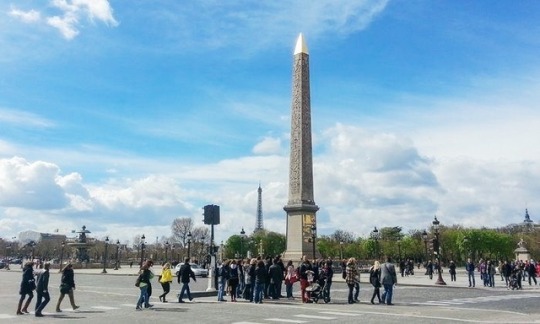
(Above: Place de la Concorde on a sunny spring day; image courtesy Archeology Travel)
Sensory Overload
Approaching the Place de la Concorde, I immediately was overwhelmed by the chaos of the traffic. Cars and motorcycles and mo-peds and buses whizzed by, one after other, in what seemed like a continuous blur. They honked and hounded one another. Some passed me by so fast I felt my breath catch in my throat. The sound of human voices, native to the Louvre and the Tuileries, was swallowed up by the rushing vehicles. My ears hurt as sirens rang out and wind slashed with each passing car.
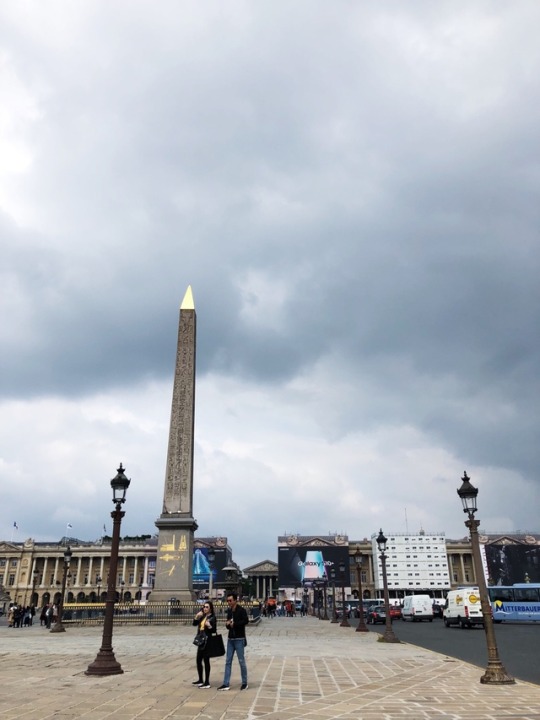
Standing at the entrance of the Place from the Tuileries, I felt as though all of my senses were on high alert...Place de la Concorde presents in equal quality elegance and extreme danger. I found myself struggling to simultaneously appreciate the elegance, purpose, and design of the place while also being aware of my fast-moving surroundings.
As I glimpsed the famous Luxor Obelisk and two monumental fountains across the street, I wondered how one could get up close to experience them— the traffic functioned as a barrier to the monuments. The only way, it seemed, was to risk my life crossing the street. Others were doing it-- couldn’t I?
Off I went.
In that moment I found myself crossing perhaps busiest crosswalk in all of Paris above ground, praying that my legs would carry me safely to my destination. I crossed successfully, thank goodness-- it wasn’t until the following day that our professors told us never to cross the pedestrian crosswalk to reach the center of the Place de la Concorde— it turns out there is an underground access point... let’s just say I completely understand their recommendation...
The View
Finally at the center of the place, the view offered me glimpses of several prestigious destinations and monuments of Paris. Turning in a circle, from this single point I could see clear down the Champs-Elyées to the Arc de Triomphe, through the Arc du Carousel to the pyramid and entrance to the Louvre, across the way to two twin mansions on either side of the opening to rue Royale (Hotêl de la Marine and Hôtel de Crillon), along with (of course) the Obelisk and two fountains closest to me. Mimicking the circling traffic around me, I continued to turn in circles to take it all in. The Place de la Concorde functioned as an impeccable space of convergence and chaotic interaction for Paris.

A Bloody Past
This first time experiencing the Place, I had forgotten of the history of it until I found myself stepping on a plaque of commemoration beneath the base of the Obelisk. The plaque mentioned the guillotining of Louis XVI and Marie Antoinette during the late 18th century. Surrounded by the elegance and beauty of the buildings and monuments around me, it was difficult for me to reconcile with the fact that where I stood used to be a place of brutality, death, and destruction. More than 1,300 people lost their lives here during the thirteen-month Reign of Terror, which was part of the French Revolution and ended with the execution of Robespierre in 1794.
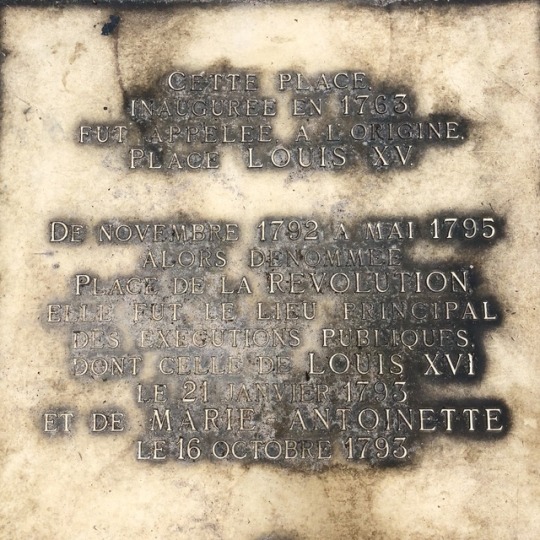
During this time period of mass killing, the Place was known as Place Louis XV. In fact, the octagon was originally created as a place to commemorate Louis XV (along with the absolute monarchy of France as a whole) by featuring an equestrian sculpture of Louis XV. Bouchardon carved the sculpture while Ange-Jacques Gabriel designed the square, er-- octagon. Yet the royal statue fell in 1792 as the French Revolution had gained full force in France at the time. By 1793 Louis XVI had been executed, with his wife soon to follow.
A Place of Peace?
After the Revolution, the Place was renamed Place de la Concorde, which means “harmony and peace”, in the hope of a better future. I laugh at this; while surely no executions have taken place here since the Revolution, the Place exists as one of the most chaotic, loud, over-stimulating destinations in Paris--and still a very dangerous site, albeit in an entirely different way.
In these terms, the name of the Place and the primary function of the Place juxtapose each other. A place of true peace? Nice try, Paris... head to Monet’s waterlilies at Musée de l'Orangerie instead... but the termination of execution is a great renovation.
DIY Renovation- Louis Philippe Style
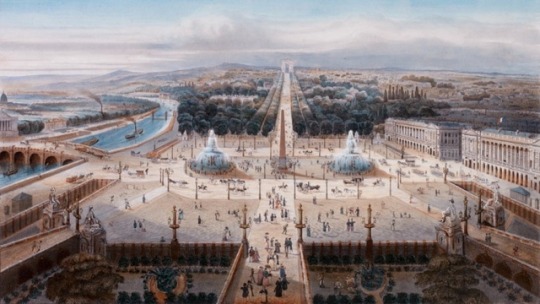
(Above: Place de la Concorde in the 19th century; Image source: Auktionshaus Zeller/Wikicommons)
In an attempt to turn the bloody legacy of Place de la Concorde around, Louis Philippe I (French King from 1830-1848) focused on renovation through decoration, installing the Luxor Obelisk and two fountains.
The Obelisk
The Obelisk, which is from the ruins of the Temple at Luxor, was no easy feat to get to Paris. Given as a gift in 1831 by Mohammed Ali Pasha, the Viceroy of Egypt, it made an excruciating trip. In some instances, ditches and pathways had to be dug for it to safely be transported. Four years later, Place de la Concorde had a new focal point, as the Obelisk was erected on October 25, 1836.

Made of pink granite, the Obelisk is 3,300 years old and stands 75.5 feet tall as Paris’s oldest monument. Covered in hieroglyphics, it indicates national time, functioning as the largest sundial in the world.
The Two Fountains

Working constantly to complete them by 1840, twelve sculptors created the two fountains in the center of the Place. Louis Philippe meant serious (and expensive!) business as he went about redecorating and redefining the Place.
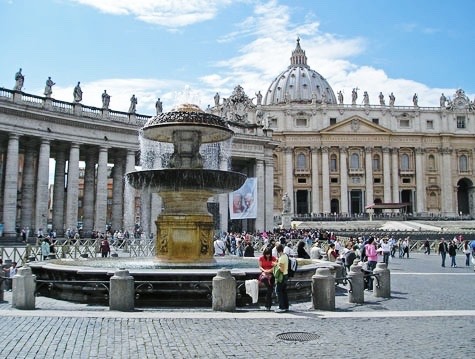
(Above: the Vatican fountain at St. Peter’s Square in Rome, Italy; image courtesy RomeItaly.ca)
The two fountains were inspired by the fountains at St. Peter’s Square in Rome, Italy. Surrounding the fountains are eight statues representing eight different French cities: Brest, Lyon, Rouen, Lille, Strasbourg, Marseille, Bordeaux, and Nantes.

Lasting Impressions
Even though it functions as a busy, dangerous, and noisy traffic circle, Place de la Concorde exists as a significant place of remembrance. Its elegance and importance are not lost, as many reputable events take place here every year, such as the “home stretch” of the Tour de France and the Bastille Day military parade led by the president.
I’ll remember Place de la Concorde for the incredible view and history lessons it offered me. Who knew one place could be indicative of so much history and feature so much art (indeed, there are many such places in Paris, it turns out!)?
For me, this Place has reiterated the idea of art as a mode of transformation. The design of a space impacts form, function, representation, and one’s interaction with it. Spaces carry meaning and convey messages; art (in this case, sculpture) can be the mode of speaking these messages, changing the narrative, and impacting a legacy.
...
And... I have something to admit: during my visit to the fountains, my friends and I may have done something a little questionable: we threw coins into the fountains and made a wish.
Au revoir!
(Sources: Michelin Paris Guide and Paris Insider’s Guide Website; all photos mine unless noted)
#france🇫🇷#france#paris#entry4#parismayterm#hopecollege#parisstories#parisfrance#parisian#parisienne#hopecollegeparis#travel#travelblog#travelparis#wanderlust#placeparis#placedelaconcorde#obelisk
1 note
·
View note
Text
“Those with nerves exhausted by work would relax there, following the restful example of those still waters, and, to whoever entered it, the room would provide a refuge of peaceful meditation in the middle of a flowering aquarium.”
—Claude Monet, 1909

#france#french#hopecollege#hopecollegeparis#paris#parisfrance#parisstories#travel#travelblog#monet#claudemonet#museeorangerie#waterlilies#art#modernart
10 notes
·
View notes
Text
Both, And

What I love most about Paris so far is that it is a place of juxtapositions. This may seems strange to admire, but this “gray” personality of Paris, how she says she’ll be not black OR white in anything— any opinion, any stance— speaks to my artist heart that always sees the world in the most colourful gray, in an attempt to find the middle ground between extremes.

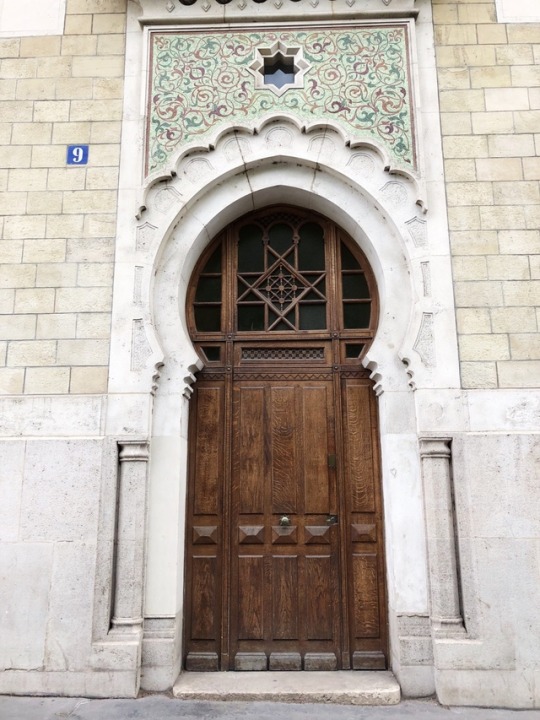
The phenomenon of being a place of such juxtaposition rings odd and inviting—odd mostly because of the differing anecdotes I glimpse being lived out before me on a day to day basis while staying here. Inviting because each of these lived stories almost beckons me to look closer, to pay attention.
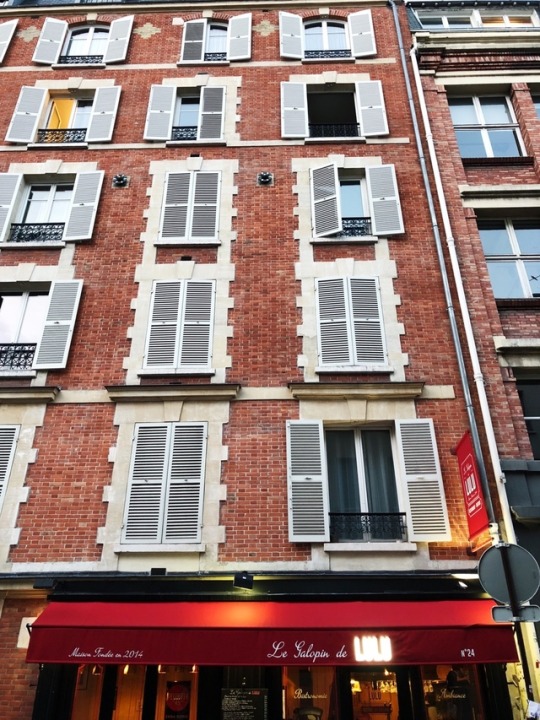
Just the other day we walked along the winding narrow streets of the 11th on the way to dinner (barely enough room for one person, let alone three, on the sidewalks!), while hours before we had stared wide-eyed at the open and majestic Haussmann-style boulevards emanating outwards from the Arc de Triomphe.
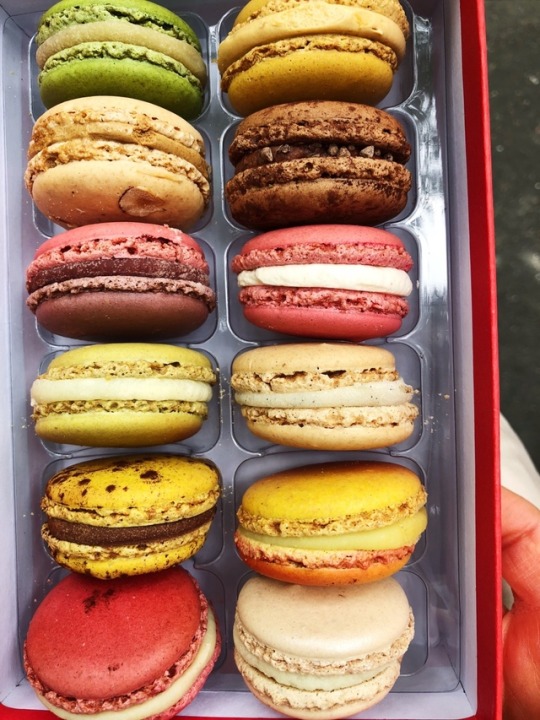
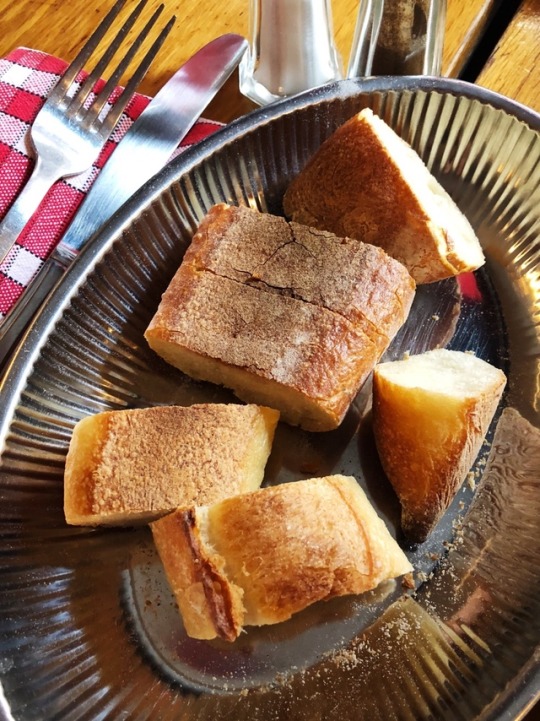
This same day we strolled down the Champs-Élysées and bought perhaps the most expensive (yet also the most delicious) macrons in Paris. The spacious boulevard was packed with shoppers clad in name brand clothes, many tourists, and the poshest shops in all of Paris. As my professor would say, the character of the Champs-Élysées could be described as shi-shi and a bit hoity-toity. We lived this narrative for the afternoon, in a pretend-fantasy-tourist sort of way (my opinions on Champs-Élysées and the wealth of the boulevard and what it stands for in France is a whole different story), yet at dinner later we became the common folk in search of not expensive sweets but simple crusty bread to fill our grumbling stomachs.
At dinner at Les Galopines de Lulu, a quintessentially French bistro, we had the kindest waitor in perhaps all of Paris. He didn’t speak much English, but he took the time to describe each item on the menu and translate it for us. In this tiny bistro, he was the only waitor present and was visibly all over the place, tending to all of the customers, managing multiple tables. One would think he would come to us Americans as stressed out and annoyed at our presence, at our incapability to speak and read French... but he came to us in the most hospitable manner and showed us utmost kindness.
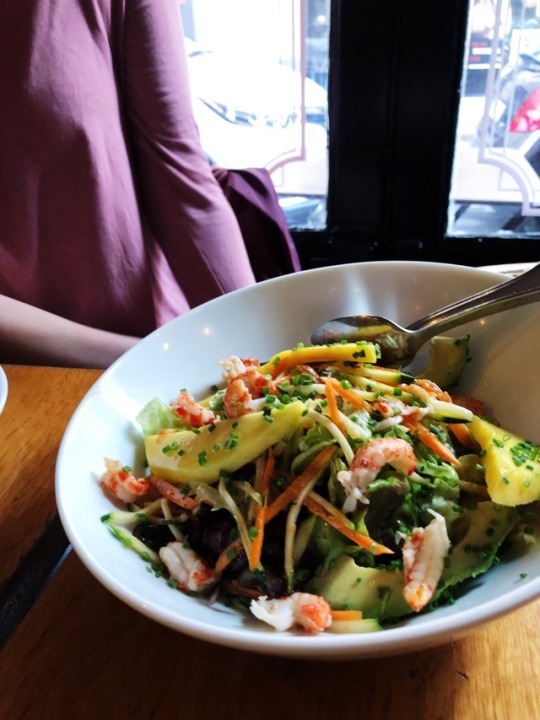
This came as a surprise when just days prior, a friend and I had gone to the grocery store in search of dinner and became the laughing stocks and frustration of all the customers in the shop as we struggled to use the self-check out machines (we thought we knew what we were doing, but it turns out even the self-check outs are different from American ones). We gathered many of the French were annoyed with our floundering, especially one of the store clerks, as he had to come over and assist us at least five times. Outsiders looking in, oui, we are un-French!
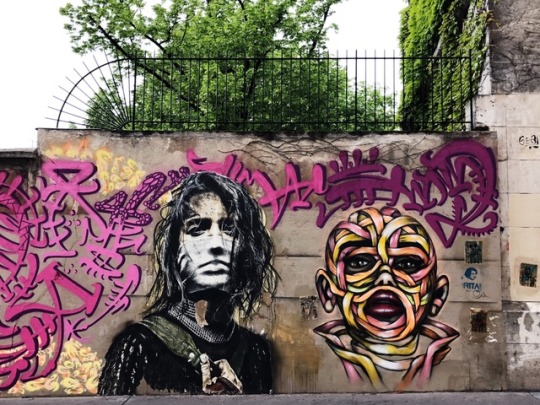
After dinner at Les Galopins, another juxtaposition to our day came about on the metro returning home that evening; we witnessed two homeless people asking for money. They called out loudly on the train while we bumbled along, walking from car to car. Many Parisians stood or sat with eyes glued to the floor, unwilling to help, set on their mission from point A to point B. Yet a few offered a handful of coins to the homeless as they passed by. How can so many in Paris be so wealthy, and also so many be so poor?

I could go on and on... Paris is rich and poor, old and new, quaint and modern, hospitable and cold, filled with young and aged, fast-paced and extremely leisurely, home to many locals and a place of destination for tourists, elegant and dingy, beautiful and ugly, building-filled and park-filled, “French” but also a giant melting pot of people from all over the world, local and metro city, neighbourhood and country, specialised and general, colourful and beige, wide open and small and narrow.
Each day seems to present different moments of juxtaposition and I find myself planted in two stories at once much of the time, fulfilling entirely different, yet related, roles. I am the outsider yet participant in Parisian society, I am confused at what I see must also delighted and inspired.
Through direct experience and immersion in Parisian culture, I am realising Paris comes to me not as a place of either/or, but rather a place of both/and.
Paris walks a fine line between the two ends of the spectrum, doesn’t invite me in all the time to make sense of it all, but every one and a while she whispers and reveals her purpose and personality and I strain to listen. I’ve been here almost a week and I feel as though I have just begun to “meet” Paris, to appreciate her narrative. Already in my mind I am missing her, anticipating my departure, yet kissing the sides of her cheeks in familiar greeting sometime in the future (I can only hope).
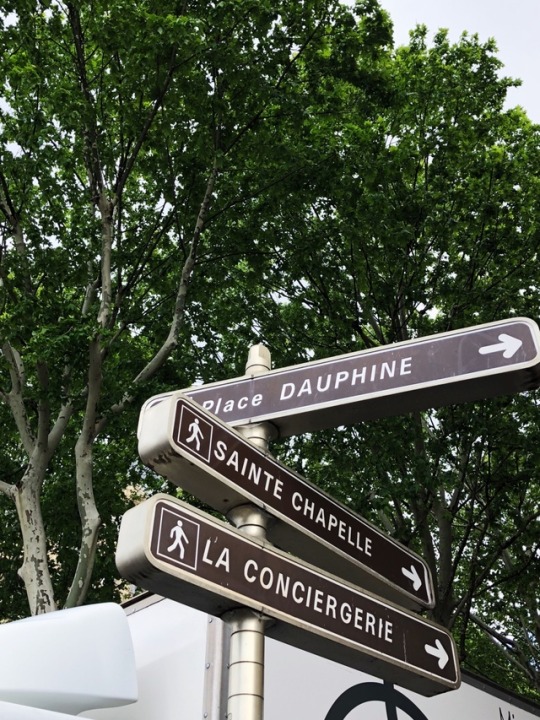
So with the remaining time I have with Paris, I will continue to get to know her. This is all I can do— will it ever stop? Does this “getting to know” ever cease with a particular place? Places forever keep changing, as we do as humans. This concept of continued change between the observed and the observer may even produce a narrative entirely different than what one had experienced a short time prior in a specific place, at a specific time.
Continued change is inevitable, but I must question legacy— what will hold true and constant, if anything, about who Paris is and who I am? I say all this to claim— people and places aren’t that different after all— we may be one in the same: changing, being, welcoming, continuing, living, speaking.
#france#french#hopecollege#hopecollegeparis#paris#parisfrance#parisstories#travel#travelblog#france🇫🇷#paris france#parismayterm#paris2019#parisienne#parisian#parisjetaime
9 notes
·
View notes
Note
What are your first impressions? So far, is Paris meeting your expectations? Anything unexpected?
First impressions- Paris is like a woman, very feline in nature. There are buildings new and old right next to each other so it seems that there is always this juxtaposition of modernity and the past... Parisians know how to relax and have a good time and be present in the moment but also because it is a city they have fast paced lives. There seem to be surprises and beautiful places all around the city- just walk and you will find something!! But also there are signs of wear and tear everywhere, certain places are more beautiful than others- which was expected. Overall I love the details of Paris... it seems like with all the architecture and presentation of even the food, they seem to admire every detail. Everything has a purpose. Sometimes that purpose is beauty. When I was coming into the city, it reminded me of India actually- the roofs are the same... and it kind of smells like India in certain places, especially in the Luxembourg Gardens near the trees that are from there!...and poverty is real here too. There are a lot of people sleeping on the streets. It’s hard in Paris for Americans and foreigners here too I’m experiencing. Ordering food was hard!!
2 notes
·
View notes
Text
Settle In
“Settle in.”


My brain is on overload currently but there is this quiet whisper within that tells me over and over again-- “Settle in, settle in.”
In essence, give in to this place, Paris, and succumb to the sights, sounds, smells, and tastes. Enjoy. Breathe. Think. Be aware, and fully alive (even if being fully alive necessitates messing up a thousand French words and getting in everyone’s way by accident on the Metro). What a joy it is to be fully alive, making mistakes and decisions, speaking and seeing and being present in Paris.



It doesn’t seem quite real that I am here. I don’t know what I think of Paris yet (how quick we are to try to make judgements!), only that I feel out of place and like I belong all at once.



It’s always astounding to me after I travel somewhere to realize that yes, 5,000 miles away, real life DOES go on in Paris, France. People live here. Just like me, they buy groceries and go to work, take classes and spend time with friends. They smile and joke (albeit in a much more reserved way), nourish themselves with food and drink, and return home at night to rest.
As an American, we are half a world away, the French and I... but suddenly my world has converged with theirs and what this means I do not know yet.


Paris holds me this evening, my tired self, full from the richest dinner I’ve possibly had. She holds me and I will give in... I’ll settle in. I’ve made it here, to this wonderfully imperfect, bold and beautiful place. And I’ll settle in.



#hopecollege#paris#parisstories#parisfrance#france#french#travel#traveller#travelblog#mayterm#hopecollegemayterm#hopecollegeparis
8 notes
·
View notes
Text
Embarking & Welcome
And suddenly, the day is here-- Paris awaits! How strange it is to wake up and look outside and realize that tomorrow my view will be entirely different. Indiana waves goodbye, while from afar the City of Light mouths, “Bonjour.” As my grandpa would say, “You’ve only got to hop across the pond!” (If only it were that easy. Flight nerves are very real this morning!)
For two weeks, I will be staying in Paris as a part of my senior seminar class at Hope College. Thirteen of us will be embarking on this journey together with our two professors. We will be exploring many of the main sites of Paris, like the Louvre, the Palais Garnier Opera, Saint Chapelle, etc., as a group most days, but we will have considerable free time to experience the city ourselves.
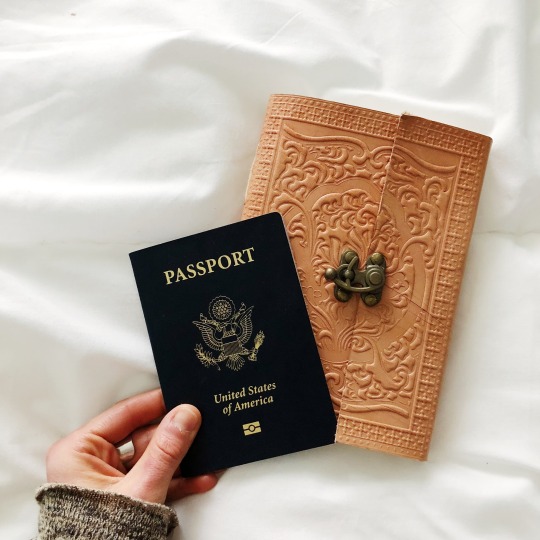
At Hope last week, we intensely studied Paris, Parisian culture, French art, and French history so that we would be able to have this free time, this leisure to explore while in Paris. For what is a trip to Paris without a somewhat leisurely approach? We Americans are always set to go, go, go... (I’ll be fighting this mindset for most of the trip, to be honest-- there’s just SO MUCH to see, yet I must settle and realize that it is impossible to see it all. So I must not try to do the impossible...).
I’m looking forward to seeing Paris in all her glory-- the art, the architecture, the culture, the beauty. My artist heart and dreamer soul will be singing. Yet I’m also seeking to discover the many complexities of Paris, the fissures and imperfections that sometimes do not meet the eye amidst the displayed elegance and drama of the city.
To “meet a place” is to consider all viewpoints, characteristics, and traits within it, through experience and acute observation. This is what I aim to do while I am in Paris. Assertions about the city and Parisian culture I will try to refrain from; rather, I want Paris to take me by the hand and show me around. In quiet reverie I will try to begin to understand this place and culture so different yet innately linked to my own human experience.
I hope you join me in this journey! Follow along for all things Paris-- in this little corner of the internet I’ll be writing about my experience, observations, French art and history, French culture, and so much more. I can’t wait to be in Paris, and I can’t wait to share what I learn and see with you! (Now for the flight-- yippee.)
Welcome to the Paris Collective, friends!
#paris#parisian#paris2019#parisstories#hopecollege#parismayterm#hopecollegeparis#france#french#parisfrance#travel#travelblog#french culture#hopecollegetravel#europe#parisienne
5 notes
·
View notes